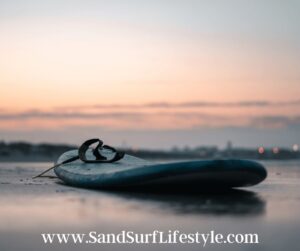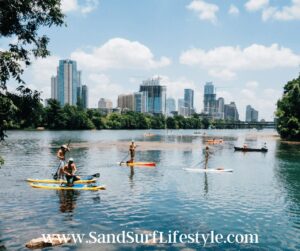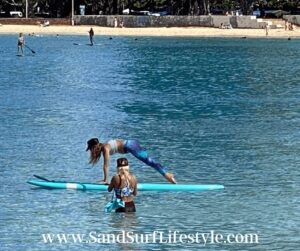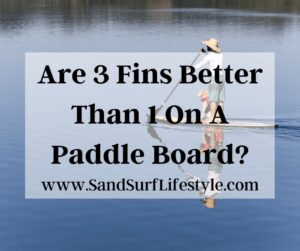Are 3 Fins Better than 1 on a Paddle Board?
Paddle boarding is a fun hobby that people enjoy on lakes, in the ocean, and on other bodies of water. It requires a stand-up paddle board and an oar and should be done wearing a life jacket. Paddle boards are solid or inflatable and come with various features, like fin configurations.
So the question is are three fins are better than one on a paddle board?
Three fins are better than one on a paddle board that’s used in surf. They give the rider better control. Paddle boards used for flatwater riding do better with just one fin because you get good tracking and stability without a lot of drag. Various configurations also provide different benefits.
In this article, we will discuss what paddle board fins do, what configurations you may find, and how inflatable paddle board fins differ from those on a solid board. Read on for help deciding how many fins are right for your needs.
What Do Fins Do on a Paddle Board?
 Paddle boards have fins on the bottom that promote better tracking and more stability. Tracking means moving forward in a straight line.
Paddle boards have fins on the bottom that promote better tracking and more stability. Tracking means moving forward in a straight line.
Riders typically stand up on a paddle board. It requires them to use core strength to keep their balance. That means switching an oar back and forth from side to side isn’t ideal.
A paddle board with better tracking allows the rider to stroke the oar more times on one side while still moving in a straight line.
The fins also provide stability to the board and thus the rider. The more stability a board has, the less rocking there is. There’s less risk of falling off the board.
Fins provide greater control to riders using boards in the surf. You’ll find varied fin lengths and configurations are better in different paddle board situations.
When Are Three Fins Better for Paddle Boarding?
A three-fin setup where the fins are all the same size is good for tracking. You’ll have excellent stability on flat water.
The problem with this setup on completely flat, calm water is the three fins create a lot of drag on the paddle board. You won’t get as much speed with your paddling due to the drag. Your strokes won’t produce as much thrust forward.
Three-fin setups are also ideal for surfing. If you’ll be using your paddle board in the ocean where there are waves and surf to navigate, three fins give you more control for turning.
When Is One Fin Better for Paddle Boarding?
One fin is ideal for riders who intend to use their paddle boards on flat water most of the time. One fin gives you the best tracking and allows you to glide over the surface of the water with little to no drag.
Your oar strokes are more efficient with one fin. Each stroke propels your board over the water with more speed than you’d get from more fins. One fin on the bottom of a solid board is designed a little differently than multi-fin configurations.
So now, let’s look at the various configurations you can choose from.
Do you know how to choose a stand up paddle board fin? Learn more here.
Paddle Board Fin Configurations
 The following are the most common fin configurations for paddle boards. Included are some tips for what their ideal uses are.
The following are the most common fin configurations for paddle boards. Included are some tips for what their ideal uses are.
- Solo fin – A solo fin is often secured to the bottom of the board with a screw. It’s positioned inside the “finbox” that has a channel down the middle. The purpose of the channel and box is to allow the fin to slide or lean back and forth. The give in the fin eliminates drag and promotes stability, as well as tracking.
- Triple fin – In a straight three-fin setup, the fins are all the same size. They’re not set within a finbox like the solo fin. They are attached directly to the bottom of the board and don’t have the give the solo fin does. They still promote stability but with a lot of drag.
- 2+1 fin – This is a different configuration of the three-fin setup. The center fin is larger than the two on the sides. The larger fin is meant to promote tracking when paddling straight. The two-side fins are smaller and designed to give the rider control to turn through the surf and on waves.
- Inflatable fins – Fins on inflatable boards come with the same configurations. The difference comes in the rigidity and the ability to remove them. You can choose rubber fins that are flexible and completely attached to the paddle board. Or you may choose fins made of semi-rigid rubber that are detachable.
What About Fin Positioning?
Some paddle boards give you the option of positioning your fin or fins. The position of the center fin affects the maneuverability of your paddle board. The center fin is placed either totally forward, far back, or at a happy medium.
When the center fin is placed totally forward, pressure is taken off the tail section of the board. Maneuverability is improved and you’ll get a tighter turning radius. If the center fin is part of a three-fin setup, though, and placed totally forward, it slows the board down.
Placing the center fin in the far back position gives you better stability. The tail is restrained with this placement, so your tracking is better, as well. The far-back position is ideal for beginners who aren’t using their boards on rough surf and aren’t doing a lot of turning.
The happy medium placement is the most balanced of the three. You get stability but without sacrificing all of your control and maneuverability. This position gives the most versatility to riders.
Final Thoughts
 Paddle boarding fins provide riders with benefits including stability, thrust, tracking, and maneuverability. Three fins are better than one for paddle boarding in specific situations. In others, one fin is ideal. The configuration of the fins is also important, though, as is the placement of the main or center fin. Choose the number of fins and positioning based on what you just learned here. It will make your paddle boarding tours both more efficient and more fun.
Paddle boarding fins provide riders with benefits including stability, thrust, tracking, and maneuverability. Three fins are better than one for paddle boarding in specific situations. In others, one fin is ideal. The configuration of the fins is also important, though, as is the placement of the main or center fin. Choose the number of fins and positioning based on what you just learned here. It will make your paddle boarding tours both more efficient and more fun.
Some Related Questions:
1. What size fin do I need for my SUP?
The best size for someone looking for more stability on their paddle board is around 8 to 10 inches. If you place the fin at the tail end of the board, you’ll get even better stability from it.
2. Are fins necessary on a paddle board?
The fins are necessary. A paddle board without fins would basically just turn around in circles. It wouldn’t have any stability. It would be difficult to paddle forward in a straight line.
3. Can I buy a fin for my paddle board?
You can buy a fin for your paddle board. Many boards come with their fins. If you are buying a separate fin, choose one based on how you’ll be using your paddle board. If you’re going to be in flat water all the time, you should get a single fin and position it based on what benefits you want most. But if you’ll be paddling out in the surf, buy a three-fin configuration so you have better.

Please note: This blog post is for educational purposes only and does not constitute legal or medical advice. Please consult a legal expert or medical professional to address your specific needs.

